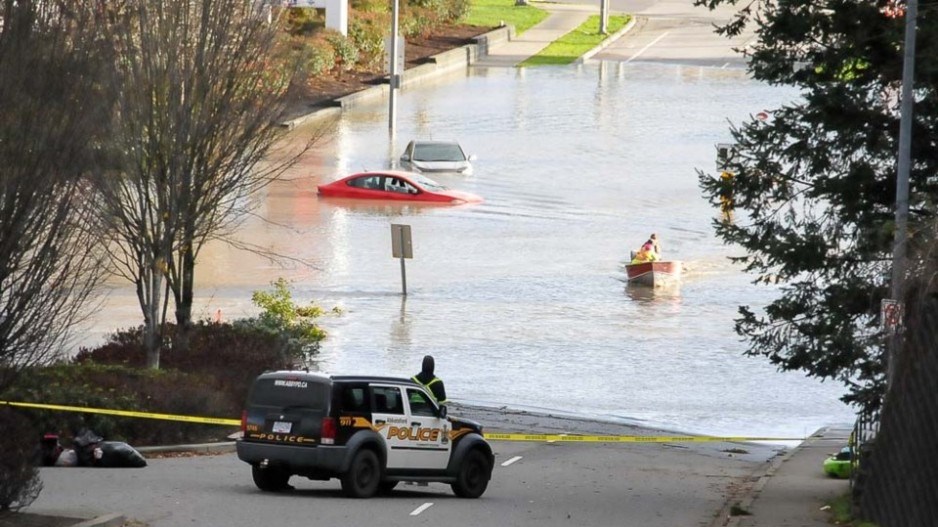When record rainfall deluged Southwest B.C. a year ago, causing farmland floods and highway landslides, a senior bureaucrat in the NDP government demanded to know what the province’s flood experts knew in advance.
Megan Harris, the assistant deputy minister of communications operations, urgently emailed the head of the River Forecast Centre on Nov. 16, 2021.
“What I'm asking for is for information only and not for public consumption,” Harris wrote in an email, obtained via freedom of information. “Can you let me know when the RFC received the first flag of rising waters that would be a concern, when the RFC sent their first notification to local governments, and how many notifications in total? Is that possible? Is it possible to get this before noon today? We have a comms briefing at noon where this would be helpful.”
RFC is a division of the Ministry of Forests tasked with assessing weather forecasts, monitoring river conditions and issuing flood warnings.
Its department head, David Campbell, responded in detail to Harris, about the challenges of predicting a disaster.
“Internally there was planning and monitoring going on behind the scenes at the River Forecast Centre throughout the week,” Campbell wrote, emphasizing that it communicated Nov. 5 with Environment Canada’s atmospheric river analysis team about storm potential for Nov. 11-15.
“Weather modelling through the week was varied in terms of timing, location and intensity of forecast storm, and was split between multiple events (including heavy rainfall on Remembrance Day).”
His staff issued 16 advisories, warnings and updates beginning at noon Nov. 13. But, Campbell stressed, the forecast event did not appear significantly different from the three to five other heavy rainstorm/atmospheric river events that happened before mid-November.
“Modelled/interpreted flows were forecast in the two-to-five year range,” he wrote.
Campbell explained to Harris that a high streamflow advisory means river levels are rising or expected to rise rapidly; major flooding is not expected, though minor flooding is possible for low-lying areas. A flood watch means river levels may approach or exceed their banks. A flood warning is just that, river levels are expected to exceed or have already exceeded bankfull.
Campbell recounted the steps his group took, including communication with U.S. officials about the potential overflow of the Nooksack River to the Sumas Prairie. Moderate, not extreme, flooding was predicted Nov. 13 and reiterated the next afternoon.
“Further communication at 4:52 p.m. on Sunday gave first indication of potential for more significant flooding on Nooksack,” he wrote.
RFC issued a high streamflow advisory at noon Nov. 13 for the South Coast and Vancouver Island in recognition of the significant atmospheric river and potential high flows.
It upgraded the Englishman River to flood watch at 9 a.m. Nov. 14, with several river modelling forecasts released a half-hour later. At that time, there was no significant indication of flood risk for the Coldwater/Tulameen Rivers, but significant flows were forecast in the South Coast/Fraser Valley/Vancouver Island regions.
A series of flood watches were upgraded Nov. 14 for Chilliwack, the Fraser Valley and Fraser Canyon and flood warnings for Tulameen, Coldwater and Coquihalla. More modelling led to additional warnings between 5 a.m. and 8 a.m. on Nov. 15 for Cowichan, Similkameen, Englishman and Fraser Valley.
“Extreme rainfall events are extremely difficult to assess for potential impacts and there is a high degree of uncertainty which makes it difficult to provide accurate forecasting well in advance,” Campbell cautioned Harris. “Generally, once heavy rainfall rates have been observed, does the scale of the event present itself — for example South West B.C. has experienced several atmospheric river events this fall that have all had the potential for significant flooding which failed to materialize.”
The RFC was established after the Fraser River flood of 1948. A November 2010 review of the RFC for the government by Mattison Enterprises found B.C. had only 5.5 full-time equivalents working in the office, compared to 24 in Alberta’s Environment River Forecast Centre and 16 at the U.S. Geological Survey Northwest River Forecast Centre.
The provincial staff directory shows the RFC has four hydrologists, two river forecast hydrologists, a river forecast technician, manager and a section head, for a total of nine.
The NDP government’s 2022 budget included $83 million for a climate preparedness and adaptation package that includes expanding RFC and buying new equipment to measure streamflow, groundwater and snowpack levels.


